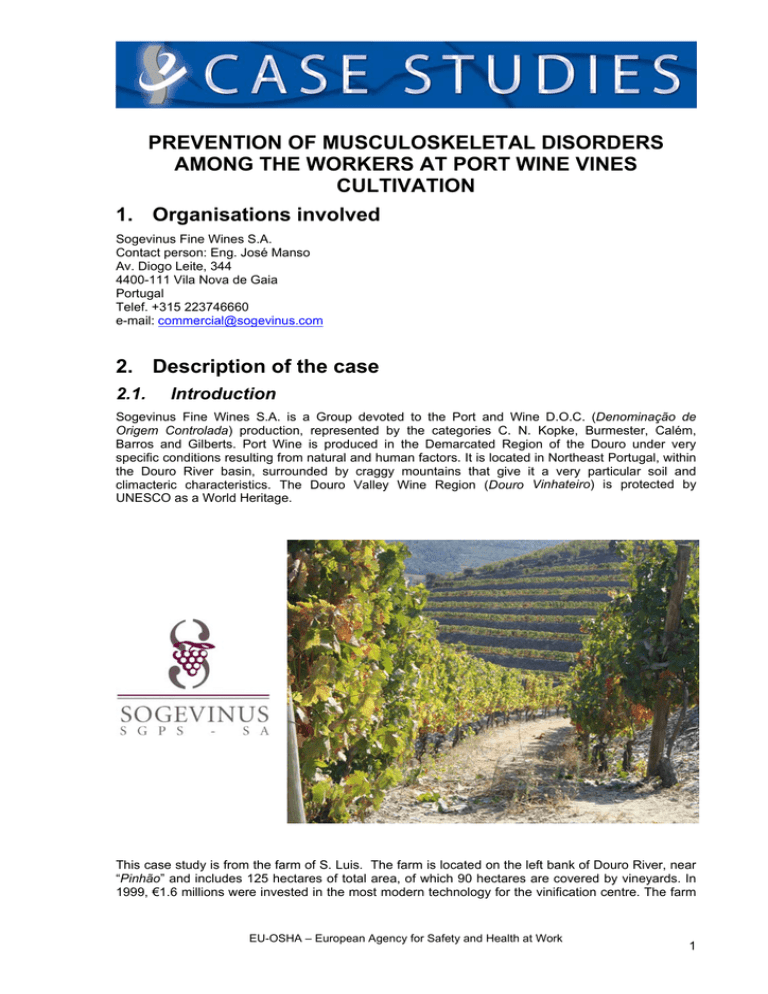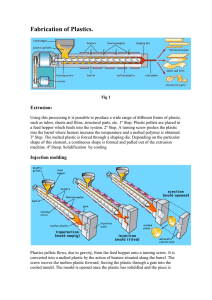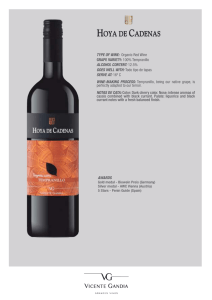PREVENTION OF MUSCULOSKELETAL DISORDERS - EU-OSHA
Anuncio

PREVENTION OF MUSCULOSKELETAL DISORDERS AMONG THE WORKERS AT PORT WINE VINES CULTIVATION 1. Organisations involved Sogevinus Fine Wines S.A. Contact person: Eng. José Manso Av. Diogo Leite, 344 4400-111 Vila Nova de Gaia Portugal Telef. +315 223746660 e-mail: [email protected] 2. Description of the case 2.1. Introduction Sogevinus Fine Wines S.A. is a Group devoted to the Port and Wine D.O.C. (Denominação de Origem Controlada) production, represented by the categories C. N. Kopke, Burmester, Calém, Barros and Gilberts. Port Wine is produced in the Demarcated Region of the Douro under very specific conditions resulting from natural and human factors. It is located in Northeast Portugal, within the Douro River basin, surrounded by craggy mountains that give it a very particular soil and climacteric characteristics. The Douro Valley Wine Region (Douro Vinhateiro) is protected by UNESCO as a World Heritage. This case study is from the farm of S. Luis. The farm is located on the left bank of Douro River, near “Pinhão” and includes 125 hectares of total area, of which 90 hectares are covered by vineyards. In 1999, €1.6 millions were invested in the most modern technology for the vinification centre. The farm EU-OSHA – European Agency for Safety and Health at Work 1 is one of the most advanced in production and selection of grapes, namely Touriga Franca, Touriga Nacional, Tinta Barroca and Tinta Roriz. Two hectares of the farm land are already cultivated as organic viticulture. Following the encouraging results there are plans to expand organic viticulture in the coming years. The vineyards are planted in horizontal terraces with earthen supporting walls, each bearing 1-2 rows of vines planted far enough apart for a small tractor to move between them and with a low planting density of some 3000 to 3500 vines/ha. More recently, as an alternative to the wide terraces, vines are being planted in vertical rows rising up the steeper hillsides (the so-called vinhas ao alto), with a planting density similar to that of traditional vineyards, (some 4500 to 5000 vines/ha). Traditionally, the vines in the region are grown low, close to the ground. The introduction of mechanization to the region at the end of the 60's and early 70's led to the appearance of interesting technical solutions with the objective to increase the efficiency of the production, the quality of the products, and the safety and health of the employees. Some of these aspects are covered in this case study. High quality wine can only be made from high quality grapes, and grapes are in prime condition for just a few days. Picking wine grapes near optimum ripeness is very important. In this sense the technical winemakers from the farm start sampling the grapes well before harvest time. The grape harvesting takes place during the month of September, normally for a period of 30 days. Grape harvesting is an age-old tradition that still occurs to this day. Grapes are picked by hand (mechanical grape harvesting has not been applied in the Demarcated Region of the Douro). The grape picking process involves workers who pick, gather and transport the grapes to the crushing stage. When a grape is ready to be picked, workers take to the fields. Pickers line the vineyard rows where the grapes are located equipped with a 5 kg capacity plastic bucket and scissors. At each grapevine, the pickers stop and cut-off a group of grapes. Those grapes are placed inside the 5 kg capacity plastic bucket. When the plastic bucket is full of grapes, it is transferred to 20 kg capacity plastic boxes previously disposed along the vineyards. At this point, gatherers collect the plastic boxes disposed among the rows with small tractors. Those boxes are carefully pilled in the back of the tractors, and transported among the rows to reception points located in the vineyard, where a 3,5 tons open box truck is located. The 20 kg plastic boxes are transferred to the 3.5 tons truck and delivered to the crushing stage. The boxes are then unloaded from the truck and turned into the equipment where the grapes will be processed. The empty boxes after been cleaned return to the vineyards to be disposed again along the vineyards. 2.2. Aims A high productivity is crucial in the rural production in order to reduce exploitation costs and to increase the international competitiveness of the products. Grapes have to be carefully collected by hand and carefully located in boxes, protected from the deterioration resulting from the crushing of grapes. All the organisation of work associated with the grape harvesting and transportation to the processing equipment was implemented with three fundamental objectives: (1) To reduce, as much as possible, the manual effort associated with the transportation of grapes from the vines to the processing equipment and consequently the risk of musculoskeletal disorders (MSDs); (2) To increase the productivity of the vine harvesting process; EU-OSHA – European Agency for Safety and Health at Work 2 (3) To assure a high quality harvesting process, avoiding the excess of weight in the transportation of grapes and the consequent crushing of grapes in the buckets, maintaining the quality and integrity of the product. 2.3. What was done, and how? The system of work implemented at the farm of S. Luis, in particular focusing on reduction of human effort and MSD risk reduction, covered: the preparation of the land; technical solutions involving the grape harvesting; the transport of grapes and; the management of working teams. (1) The preparation of the land and particularly the accessibility from the horizontal terraces to the main roads disposed along the parcels is fundamental to easily mechanize the transport of grapes and the access of tractors to the terraces. The horizontal terraces bears 2 rows of vines planted far enough apart for a small tractor to move between them and with a low planting density of some 3,000 to 3,500 vines/ha and in vertical rows rising up the steeper hillsides with a planting density of some 4,500 to 5,000 plants per/ha. The preparation of land and the accessibility to the parcel (2) Regarding the height of the vines, the first row of vines is located at 600 mm and reaches a height as much as 1.30 to 1.60 m. This is an important factor affecting the working postures of the employees. The height of the grapes is between knee and shoulder level during grape harvesting. (3) The disposal of the vines aligned by bilateral cordons and the relatively low density of vines reduces the human effort during vines preparation and harvesting process. Bilateral cordons are used for training the vines, avoiding repetitive hand and wrist movements to fix the vines to the steel cordons. EU-OSHA – European Agency for Safety and Health at Work 3 Bilateral cordons are used for training the vines (4) Portable electric scissors are used to trim the vines avoiding repetitive fingers and wrist movements as with traditional scissors. Trimming the vines is performed after October and takes a team of 4-6 employees working 3 month, 8 hours a day. Portable electric scissors are used to trim the vines (5) A small tractor working between rows of vines uses a tilt land crusher which performs most of the vineyard land work. Considering a 90 hectares vineyards, this work takes nearly 1 month and is repeated 2-3 times a year. The tractor dedicated to this job at the farm of S. Luis is particularly comfortable, equipped with radio, air conditioning and anatomic seat. A small tractor performs most of the vineyard land work EU-OSHA – European Agency for Safety and Health at Work 4 (6) Normalized plastic boxes are used to receive the grapes from the vines during grape harvesting. More recently boxes with several holes in the bottom surface are used. The objective is to limit the weight of the boxes to 20 kg, by avoiding the compression of excessive amount of grapes into the boxes. The liquid that results from the compression of an excessive volume of grapes per box is visible in the bottom surface of the boxes. Those boxes are moved by two workers. Normalized plastic boxes with several holes in the bottom surface are used to receive the grapes from the vines and to limit the volume of grapes in the box Several 20 kg capacity plastic boxes are initially disposed along the vineyards, to receive the grapes. The plastic boxes are initially aligned with the vineyards to receive the grapes (7) Pickers line the vineyard rows where the grapes are located equipped with a 5 kg capacity plastic bucket and scissors. At each grapevine, the pickers stop and cut-off a group of grapes. Those grapes are placed inside the 5kg capacity plastic bucket. When the plastic bucket is full of grapes, it is transferred to the 20 kg capacity plastic boxes previously disposed along the vineyards. Considering the farm of S. Luis this work is performed by a team of 38 employees for 30 days. EU-OSHA – European Agency for Safety and Health at Work 5 Grapes are placed inside a 5kg capacity plastic bucket and transferred to a 20 kg capacity plastic boxes (8) Gatherers collect the plastic boxes disposed among the rows with small tractors. Those boxes are carefully pilled in the back of the tractors and transported among the rows to reception points located in the vineyard where a 3.5 tons open box truck is located. Those boxes are handled by two employees. Eight employees perform this activity for 30 days. Job rotation between pickers and gatherers is practiced. (9) The 20 kg plastic boxes are transferred to the 3.5 tons truck and delivered to the crushing stage. Considering the weight of the load, those boxes are handled by two employees. The plastic boxes are transferred to the 3.5 tons truck (10) The boxes are then unloaded from the truck and turned into the equipment where the grapes will be processed. The empty boxes after been cleaned return to the truck to be disposed again along the vineyards. EU-OSHA – European Agency for Safety and Health at Work 6 The boxes are unloaded and turned into the processing equipment (11) Regarding organisational aspects related to the prevention of MSDs at work, job rotation between grape pickers and boxes gatherers is practised. This procedure has the objective to reduce the MSD risk factor associated to sustained trunk flexion during the harvesting process and to relief the extension trunk muscles from the manual handling of boxes. (12) Regarding social aspects related to the prevention of MSDs at work, a passengers´ truck is used to transport the workers between the office area and the vineyards work locations. The working time is between 7:30 to 17:00, with a 30 minutes break at 9:00 and one hour break at 13:00 to lunch time. Lunch is served in the farm at a very comfortable area, with excellent conditions to allow workers to recover from fatigue. (13) The employees receive training regularly. Topics covered in the training sessions include trimming technique, application of phytosanitary products and manual handling of loads. 2.4. What was achieved? The main results achieved by the organisation of work implemented at farm of S. Luis (Sogevinus Fine Wines S.A.) were: a reduction in manual effort associated with vine harvesting and transportation of grapes from the vines to the processing equipment; an increase in the efficiency and productivity of the vine harvesting process as well as in the transportation process of grapes to the processing equipment (crushing stage); an increase in the quality of the grapes (avoiding crushing of grapes). The reduction in manual work involved in the farm, allowed temporary non-experienced older employees to perform the job during the months of September and October with a low risk of occupational diseases, particularly MSDs. 2.5. Success factors The international competitiveness in the rural products as well as need to make the workplaces healthier and safer was the main factors that promoted the modification of the whole production process. The opinion of the workers regarding good work practices were carefully considered by the managers of the company. The preparation of the land, the technical solutions regarding grapes harvesting and transportation was the result of both the consultation of the workers, and the support and implementation of “know-how” of the managers. EU-OSHA – European Agency for Safety and Health at Work 7 The vision of the company in terms of “fully satisfying the clients' needs, expectations and welfare of employees, increasing qualitative and quantitative objectives of shareholders” was also an important success factor. 2.6. Further information Further information may be obtained by contacting the organisation involved. 2.7. Transferability The solutions presented in this case study are transferable, particularly to vineyards in horizontal terraces involving hand collected fruits. 3. References, resources: Sogevinus Fine Wines S.A. http://www.sogevinus.com/ Port and Douro Wines Institute (IVDP) http://www.ivp.pt/index.asp Porto Barros / Quinta S. Luis http://www.porto-barros.pt/client/skins/english/site.htm Quinta S. Luis http://www.departuresandarrivals.travel/sistema/fck/docs/files/enoturismo_4_pt.pdf EU-OSHA – European Agency for Safety and Health at Work 8



